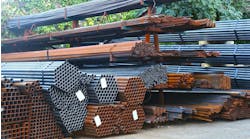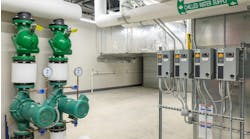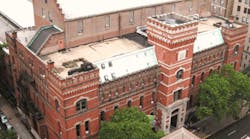Latest from Home
Sponsored
NEW YORK — The Park Avenue Armory, built by the National Guard’s prestigious Seventh Regiment in the 1880s and now a National Historic Landmark, is undergoing renovation, which includes HVAC upgrades, installation of a plumbing system for new bathrooms in the basement and an overhaul of its electrical systems. The entire project is being renovated to U.S. Green Building Council LEED Silver standards, and will take approximately four years to complete.
According to John F. Overend, vice president of Tishman Construction Corp., phases one through four, included heating and theatrical rigging work in the 55,000-sq.ft. Wade Thompson Drill Hall, and the future interior and exterior phases will expand on that scope.
Tishman Construction installed a new chiller plant in the basement, and new cooling towers by Evapco, along with air handling units from Buffalo Air Handling with Aerofin coils, within the building’s existing turrets. These will work together to provide air conditioning and permit the Armory to host events in the summer, which it could not do previously. Tishman also oversaw the installation of a new steam connection with Con Edison, and new bathrooms in the basement were roughed for future finishes, including underground waste connections.
When installing the cooling towers within the existing turrets, Tishman and the subcontractor worked with 130-year-old masonry, integrating it to new steel frames within the towers to support the new cooling units. To make room for the Multistack chillers, Con Edison steam service connection, and new bathrooms in the basement, workers had to remove load bearing walls.
“Slab on grade for the steam and future bathrooms was lowered by one foot to accommodate required ceiling heights,” explained Overend. “Excavation uncovered 100+ year old loose laid rubble and granite block foundations, which needed to be hand excavated and shored prior to pouring new slab. The walls removed required shoring of the first floor wood deck and installation of new structural steel tied into the existing masonry supporting walls.”
Tishman also coordinated the installation of a quiet, hot water radiation system that engineers AKF Group LLC designed, located at the perimeter of the Drill Hall, which will allow for performance presentations in the winter months.
Instead of using an individual boiler plant, the Armory is using pressure-reduced steam for winter heating, domestic hot water heating, air conditioning and process loads.
AKF Group, the project’s mechanical engineering firm, evaluated the feasibility of utilizing the high-pressure steam services versus on-site boilers for heating, domestic hot water and absorption chillers.
Chris McHugh, partner at AKF, told CONTRACTOR that there were up-front costs, ongoing maintenance costs, environmental emissions and space considerations that became factors in addition to the difference between the costs of buying steam from Con Edison versus generating steam via a boiler plant.
“There are many factors that weigh in on this decision; some of them are the construction constraints, type of facility, operating hours and proximity to the source of Con Edison steam,” said McHugh.
The steam system began in 1882 when New York Steam Co. began providing service in lower Manhattan. Today, the Con Edison steam system generates high pressure steam and distributes it to a wide area of New York City via a system containing approximately 105 miles of mains and service pipes, providing steam for heating, hot water, and air conditioning to commercial and residential customers in Manhattan. There are five Con Edison steam-generating plants, three in Manhattan, one in Queens, and one in Brooklyn. In addition, steam is received under contract from a steam plant at the Brooklyn Navy Yard.
According to Overend, there were a few challenges when installing the steam connection.
“The main issue was incoming service coordination with the steam service provider, (Con Edison) which entered the building below the existing building rubble foundation,” explained Overend. “Hand excavation and shoring were required to create the opening and mechanical service pit adjacent to the foundation. Other challenges were sound and vibration isolation of new equipment which were located beneath and supported by the wood framing supporting a landmarked historic room above used as a museum and performance/lecture space.”
According to McHugh, along with the steam system, steam pressure reducing valves by Spence, steam traps, hot water heat exchangers and pumps by Bell & Gossett, expansion tanks and air separators have been installed as part of the water heating system.
“We are thrilled to have made so much progress in stabilizing this historic treasure as a non-traditional home for the arts,” said Rebecca Robertson, president and CEO of the Armory. “The Armory is an exceptional building, reflecting the most cutting-edge designers of a previous era, and now providing a home for contemporary, cutting-edge arts productions. The building and its interiors must be treated with the utmost respect for detail and historic preservation. Our colleagues at Tishman have been terrific partners in this project, injecting an intense level of care into the intricate process of stabilizing and upgrading this extraordinary space.”
Future phases of the project include a newly created mechanical room that will house the Administration building’s refrigeration plant, heating distribution, electrical distribution and air handling system.
Related Articles:
Bank of America Tower’s co-gen plant provides 65% of energy
Candace Roulo
Candace Roulo, senior editor of CONTRACTOR and graduate of Michigan State University’s College of Communication Arts & Sciences, has 15 years of industry experience in the media and construction industries. She covers a variety of mechanical contracting topics, from sustainable construction practices and policy issues affecting contractors to continuing education for industry professionals and the best business practices that contractors can implement to run successful businesses.


